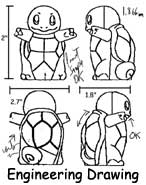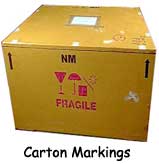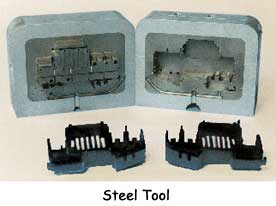 Step
Six: Engineering Drawings / QAP Request – Once
you have awarded the project you might have to send engineering
drawings that show how the item works or is constructed
to the testing lab that you are going to work with. Either
in-house engineers or ones at the favctory will supply these
drawings.
Step
Six: Engineering Drawings / QAP Request – Once
you have awarded the project you might have to send engineering
drawings that show how the item works or is constructed
to the testing lab that you are going to work with. Either
in-house engineers or ones at the favctory will supply these
drawings.
The criteria to determine how to test an item
will depend on the age grading of the item and how the product
is intended to be used. It is the responsibility of the
testing lab to evaluate your designs to make certain that
they can meet the requirements that you need for safety.
They will then make a Quality Assurance Plan (QAP) that
they will make certain your factories are following during
production.
Step Seven: QA Plan Sent To The Manufacturer
– Once the testing lab has provided an approved QAP,
this is then sent to the manufacturer as the guideline for
them to follow in producing the product. This QAP plan will
let the factory know what types of testing will take place
to make certain the product they are producing will be safe
and function properly in the environment it is intended
for. The QAP plan will also be followed closely by your
own Quality Assurance staff in Hong Kong to make certain
that the factory is conforming to everything in the QAP.
 Step
Eight: Sculpts Sent To Hong Kong – Now that the
model maker has completed the sculpts and they have been
approved by the client and the licensor if necessary, they
are sent to the Hong Kong office to be given to the factory.
Depending on the product and license holder, approvals can
sometimes take multiple submissions, which should also be
factored into the timeline. At this time the factory will
make a duplicate model called a “looks like” model
and also a “works like” model which will show
the function that the product is supposed to do. These should
represent what the final product should look like and behave
like in the store. This is where you iron out most issues
in the design and make sure the factory is on the same page.
Step
Eight: Sculpts Sent To Hong Kong – Now that the
model maker has completed the sculpts and they have been
approved by the client and the licensor if necessary, they
are sent to the Hong Kong office to be given to the factory.
Depending on the product and license holder, approvals can
sometimes take multiple submissions, which should also be
factored into the timeline. At this time the factory will
make a duplicate model called a “looks like” model
and also a “works like” model which will show
the function that the product is supposed to do. These should
represent what the final product should look like and behave
like in the store. This is where you iron out most issues
in the design and make sure the factory is on the same page.
 Step
Nine: Request Carton Markings – At this point the
account team needs to find out the information that the
client will require on the master cartons. This information
is required early in the production process due to the lead
time to produce the master cartons. Typically, each client
has certain specific information about the product and stocking
codes that they want printed on their master cartons. This
is also when you will begin to work on the creative and
copy for any inserts, decals and polybags required for the
project but not needed until later.
Step
Nine: Request Carton Markings – At this point the
account team needs to find out the information that the
client will require on the master cartons. This information
is required early in the production process due to the lead
time to produce the master cartons. Typically, each client
has certain specific information about the product and stocking
codes that they want printed on their master cartons. This
is also when you will begin to work on the creative and
copy for any inserts, decals and polybags required for the
project but not needed until later.
 Step
Ten: Legal Line Information – On every tool that
is made for the item you are manufacturing there needs to
be a client legal line included along with the country of
origin (ie) “Made In China”. This information
which may be the copyright logo along with the client logo
needs to be etched in the tool and is required prior to
the start of tooling. Once the tooling has begun this information
is difficult to change or add to and requires modifications
to the tooling. This is usually the last item added to the
tool. Tooling usually takes around 45 days, since the pattern
is being made by cutting into a block of steel then milled,
drilled, and polished.
Step
Ten: Legal Line Information – On every tool that
is made for the item you are manufacturing there needs to
be a client legal line included along with the country of
origin (ie) “Made In China”. This information
which may be the copyright logo along with the client logo
needs to be etched in the tool and is required prior to
the start of tooling. Once the tooling has begun this information
is difficult to change or add to and requires modifications
to the tooling. This is usually the last item added to the
tool. Tooling usually takes around 45 days, since the pattern
is being made by cutting into a block of steel then milled,
drilled, and polished.
.






